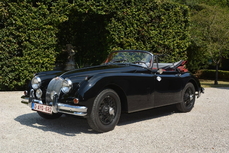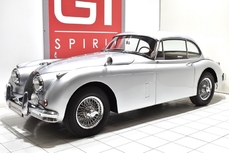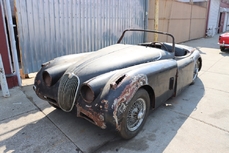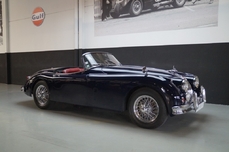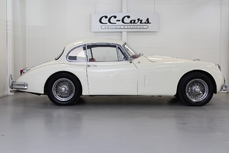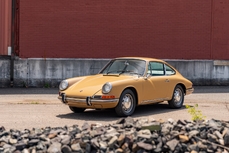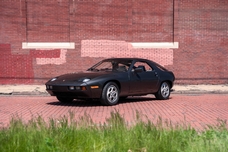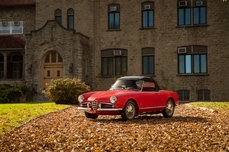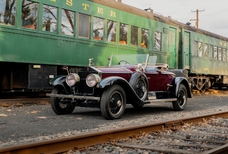Jaguar XK150 1958
General description :
- Chassis # S 830696
- Engine # V 4415-8
- Numbers Matching And Finished In Its Original Colors
- Long Term California Resident Complete With Desirable Black Plates
- A Nice Driver Quality Example Ready For Thorough Enjoyment
- Includes Factory Tools, Spare, Jack, Period Photos, Heritage Certificate, And Available Service Documentation
The final development of what began as the XK120, the XK150 was released in 1957 just one year shy of its predecessor’s 10th anniversary. In this time, Jaguar had gone to work refining and upgrading their beloved sports car both mechanically and cosmetically. By the time the XK150 hit the showroom floor, a rack and pinion steering system had been employed to control the front wheels along with telescoping shock absorbers. Additionally, the Coventry firm’s inspired development of disc brakes had been placed on the options list for the XK150 marking a drastic improvement in stopping power. Their experience on the race track had also brought about developments to the wonderful DOHC inline 6-cylinder motor and it was available in a number of specifications which began with a base double SU carburetor 3.4-liter unit and ended with a high performance bored out 3.8 liter, triple carb motor. Like before, Jaguar’s sports car could be had in 3 different flavors: an open-top two-seater, drop-head coupe, and a fixed head coupe.
Stylistically, the XK150 shared a similar form to its predecessors. However, the lines of the vehicle had been revised to fall more in line with its contemporaries. As such, the pre-war evoking dropped shoulder line was swapped out for a higher, straight-sided look. Generally, the XK150 possesses a smoother, wider look much like other bath-tub style cars from the mid-1950s. Proportionally, the car had also grown to accommodate those with larger frames and this further allowed a more comfortable driving position thanks to adjustments of the steering wheel and seat placements. Further developments included the adoption of a single-piece windscreen and a wider front grille and hood. All in, the XK150 represents a major ergonomic upgrade over its siblings.
The 1958 Jaguar XK150, chassis #S830696, offered here is a wonderful 3 owner, matching numbers (engine #V4415-8) example originally delivered to a presumed UCLA professor named Richard Kornhauser of Escondido, California. Both the original vehicle title and the Jaguar Heritage Certificate confirm this information and like most Jags of the period, it arrived onto our shores through Hoffman Motorcars in New York. Importantly, the Jaguar is a bonafide CA black plate example. After over 20 years in the dry southwest climate, the XK150 was purchased by a Nazareth, Pennsylvania-based individual in 1982. At some point within this new ownership, the Jaguar had its interior refinished in the delivery correct specification of red. Consistently well cared for, the vehicle was preserved in climate-controlled storage during this period. When the property which held the car was sold in 2016 when the current owner became the next caretaker.
During the same year as the sale of the property, the Jaguar was sent to K&T Vintage Sports Cars LLC of Allentown, PA for a recommissioning. Invoices on file detail the numerous jobs performed on the vehicle which included fixing a coolant leak issue with new hoses and a new radiator. Additionally, some wiring issues were fixed within the dash to address an ill-functioning turn signal along with some other electrical gremlins. Further, the car received new tires and chrome wheels (the originals will be included upon sale.) Lastly, the new mirrors were fitted along with a new clutch slave cylinder. Additional work is detailed in these invoices and is available for viewing.
Thanks to its extended stay in the dry California environment, this XK150 presents as a wonderful driver-quality car with minimal signs of corrosion. There is a lovely mix of original and new parts as the Jaguar was repaired as needed throughout its life. While some cosmetic flaws are apparent, they are inviting in quality and alleviate any anxiety one might have of damaging the car on a drive. Today, the XK still wears its attractive delivery colors of cream over red leather and additionally, the Jaguar sports disc brakes. Further evidence of the care placed onto this XK150, it arrives complete with a wonderful suite of accouterment including original tools in reproduction roll, jack, owner’s manual, and a new spare tire.
A well-preserved example such as this is sure to remain a desirable entity within the classic car hobby for decades to come. As the final evolution of the XK nameplate first introduced in the 1940s, these cars are well refined and comfortable to operate. They offer everything one could want from a classic Jag: handsome looks, a sonorous, powerful motor, and sporty handling.
Please visit http://www.LBILimited.com for many more photos and details. Follow us on Instagram and Facebook @LBILimited. Ride along on our classic car adventures by subscribing to LBI Limited on YouTube. #claimyourclassic™
Document description :
1958 Jaguar XK150 is listed sold on ClassicDigest in Philadelphia by Adolfo Massari for $95000.
Car Facts
Car type : Car Make : Jaguar Model : XK150 Engine size : 2.6 Model Year : 1958 Sub type : Convertible Condition : 4 Location : Philadelphia, PA Vehicle Registration : Normal
Sold
Seller Information
Sold
People who viewed this Jaguar XK150 also viewed similar Jaguar listed at ClassicDigest
Other cars listed for sale by this dealer
About Jaguar
Ah, the story of Jaguar, from its early days as the SS Cars Ltd. to its pinnacle with the D-type, and the street-going evolution in the form of the iconic E-type. There's something quintessentially British about this tale, and I'll narrate it as a British journalist might.In the Beginnings:
Our journey into the world of Jaguar begins in the 1930s, when a company known as SS Cars Ltd. emerged. Despite the unfortunate coincidence of their initials with the rising political tensions in Europe, they started producing stylish and performance-oriented cars. The SS 100, introduced in 1936, was a symbol of elegance and speed, setting the stage for what would become Jaguar.
The Birth of Jaguar:
As the shadows of World War II loomed, SS Cars Ltd. wisely decided to disassociate themselves from the SS initials. Thus, in 1945, they officially became Jaguar Cars Ltd., a name that would soon be synonymous with British luxury and performance.
The XK Series:
Jaguar's post-war era brought us the XK 120, a true sensation in 1948. With its sleek design and a powerful 3.4-liter inline-six engine, it became the world's fastest production car. The XK 120 was the blueprint for what lay ahead – Jaguars that blended style with speed in a uniquely British fashion.
The D-type Dominance:
Then came the D-type, a true racing legend. Introduced in 1954, it won Le Mans three times in the 1950s, showcasing Jaguar's engineering prowess. With its innovative monocoque construction and the iconic fin at the back, the D-type was the apex of Jaguar's motorsport success.
The E-type Emergence:
But the true turning point arrived in 1961 with the introduction of the E-type, often described by Enzo Ferrari as "the most beautiful car ever made." Its long bonnet, curvaceous body, and a 3.8-liter engine delivering exhilarating performance made it an instant classic. The E-type was not just a car; it was a work of art on wheels, and it could hit 150 mph on the road.
Street and Racing Success:
The E-type's beauty was matched by its capability on the track. The lightweight E-types were particularly successful in various racing events, cementing Jaguar's reputation as a force to be reckoned with in motorsport.
The Age of Refinement:
As we delve deeper into the Jaguar story, we find that the 1950s and 1960s were an age of refinement and expansion. Alongside the magnificent D-type and the E-type's iconic emergence, Jaguar introduced models that further solidified its reputation for luxury and performance.
The MK2:
In the late 1950s, Jaguar unveiled the MK2, a sports sedan that combined elegance with power. This sleek four-door saloon was a favorite of bank robbers and law enforcement alike, thanks to its exceptional speed and handling. The MK2 was a symbol of Jaguar's ability to blend sophistication with performance and had a successful racing career as well.
The XJ6:
Fast forward to 1968, and Jaguar launched a car that would define luxury saloons for decades to come – the XJ6. It was a masterpiece of engineering and design, featuring a smooth inline-six engine, independent rear suspension, and a spacious, beautifully appointed interior. The XJ6 was a symbol of British elegance and provided a ride so smooth that it seemed to glide over the road. It became the flagship model for Jaguar and set the standard for luxury saloons, showcasing a level of refinement that left competitors in awe.
The Blend of Classic and Modern:
While the MK2 and XJ6 represented the evolution of Jaguar's saloon cars, they maintained the brand's commitment to performance and luxury. These cars didn't just belong on the racetrack; they were equally at home cruising down the grand boulevards or gliding through the English countryside.
The Challenges of Change:
However, as the 1970s arrived, Jaguar, like many British automakers, faced financial challenges and changes in ownership. The British Leyland era brought both opportunities and struggles, as the brand navigated through various mergers and transitions.
Nevertheless, the legacy of the MK2 and XJ6, along with the D-type and E-type, continues to define Jaguar as a manufacturer that combines timeless elegance with a spirit of performance. These classic models, whether driven on winding roads or parked as collectors' treasures, serve as a testament to Jaguar's enduring presence in the world of automotive excellence.
The Jaguar story, from its early days as SS Cars Ltd. to the creation of automotive icons like the E-type, MK2, and XJ6, is a journey that reflects the very essence of British motoring – a blend of luxury, power, and style that continues to captivate enthusiasts and connoisseurs alike.


























